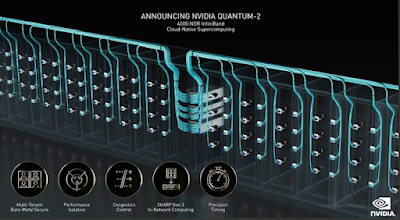NVIDIA announced the next generation of its InfiniBand networking platform for cloud computing providers and supercomputing centers.
NVIDIA Quantum-2 is a 400Gbps InfiniBand networking platform that consists of the NVIDIA Quantum-2 switch, the ConnectX-7 network adapter, the BlueField-3 data processing unit (DPU) and all the software that supports the new architecture.
NVIDIA Quantum-2 includes key features required for demanding workloads running in either cloud enviroments or superomputing clusters. The multi-tenant performance isolation of NVIDIA Quantum-2 keeps the activity of one tenant from disturbing others, utilizing an advanced telemetry-based congestion control system with cloud-native capabilities that ensure reliable throughput, regardless of spikes in users or workload demands.
NVIDIA Quantum-2 SHARPv3 In-Network Computing technology provides 32x more acceleration engines for AI applications compared with the previous generation. Advanced InfiniBand fabric management for data centers, including predictive maintenance, is enabled with the NVIDIA UFM® Cyber-AI platform.A nanosecond-precision timing system integrated into NVIDIA Quantum-2 can synchronize distributed applications, like database processing, helping to reduce the overhead of wait and idle times. This new capability allows cloud data centers to become part of the telecommunications network and host software-defined 5G radio services.
The Quantum-2 platform is powered by new Quantum-2 InfiniBand switching ASIC with 57 billion transistors implemented in 7-nanometer silicon. It features 64 ports at 400Gbps or 128 ports at 200Gbps and will be offered in a variety of switch systems up to 2,048 ports at 400Gbps or 4,096 ports at 200Gbps — more than 5x the switching capability over the previous generation, Quantum-1.
The NVIDIA Quantum-2 switch is now available from a wide range of leading infrastructure and system vendors around the world, including Atos, DataDirect Networks (DDN), Dell Technologies, Excelero, GIGABYTE, HPE, IBM, Inspur, Lenovo, NEC, Penguin Computing, QCT, Supermicro, VAST Data and WekaIO.
“The requirements of today’s supercomputing centers and public clouds are converging,” said Gilad Shainer, senior vice president of Networking at NVIDIA. “They must provide the greatest performance possible for next-generation HPC, AI and data analytics challenges, while also securely isolating workloads and responding to varying demands of user traffic. This vision of the modern data center is now real with NVIDIA Quantum-2 InfiniBand.”



















